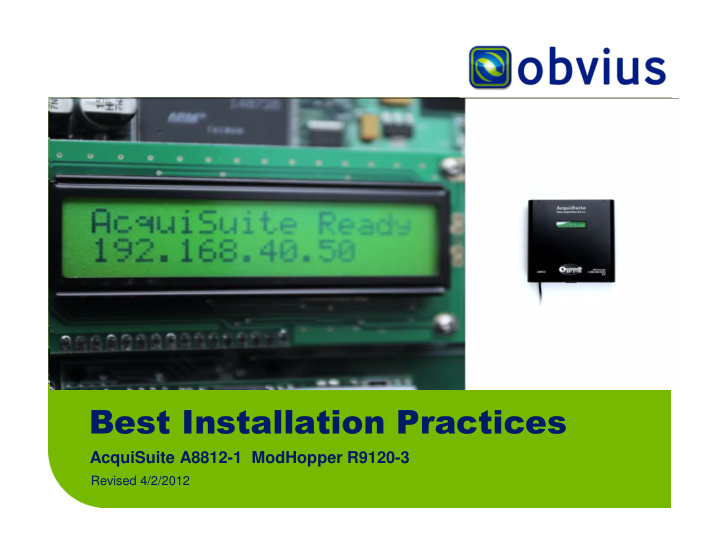



��������������������������� AcquiSuite A8812-1 ModHopper R9120-3 Revised 4/2/2012
������ • General best practices guidelines • Site survey best practices • Installation best practices • Commissioning best practices
General best practice guidelines
���������������������� � BP #1: Avoid objects or locations likely to interfere with radio signals: � Cell repeaters � Metal cans or housings � Thick concrete walls � BP #2: Allow minimum of 10 feet of separation between ModHoppers
�������������������������� � � BP #3: Each Modhopper must have a Modbus address that is unique from all other Modbus devices on the network � BP #4: Consult factory before wiring ModHoppers together on RS 485 � BP #5: Keep ModHoppers away from conduit or sources of electrical noise
�������������������������� � � BP #6: Avoid adding hops to long runs as this will increase latency, consider hard wiring if possible � BP #7: Use shielded twisted pair (Belden 1120A or equivalent) � � BP #8: Use additional ModHoppers to balance the load in high density areas
�������������������������� � � BP #9: Use high gain antennas with caution as they may cause the network to shift high traffic levels to the high gain segment � BP #10: If you are using Modbus meters, limit the number of devices per AcquiSuite to 70 or less to maintain acceptable throughput
Site survey best practices
�������������������������� � BP #1: Map the quantities physical locations of meters on a layout of the building to properly balance the loads
������������������������������ � � BP #2: Add ModHopper(s) to the layout to look for logical communication sub-networks � BP #3: Try to minimize the number of “hops” that data must make to reach the AcquiSuite as each hop adds latency to the network � BP #4: Assign Modbus addresses to the ModHoppers on the layout to avoid duplication later
����������������������������� � � BP #5: If possible, locate the AcquiSuite(s) as close as possible to the center of the building � BP #6: Arrange nodes in a star or cluster rather than a linear arrangement � BP #7: Whenever possible, locate the ModHoppers on outside walls to minimize the amount of metal that will be encountered
����������������������������� � � BP #8: Large clusters of Modbus meters should have 3 hops or less to the AcquiSuite � BP #9: Areas where cell phone coverage is poor are also likely to be poor locations for ModHoppers
����������������������������� � � BP #10: Verify with site personnel the presence of cellular repeaters or WiFi networks as they may cause interference
Installation best practices
��������������������������� � BP #1: Mount the ModHoppers a minimum of 10 feet from other radios (including other ModHoppers) � � BP #2: Do not mount the ModHopper on metal or with the antenna touching conduit
������������������������������� �
������������������������������� � � BP #3: Do not mount the ModHopper on a wall with lots of metal on the other side as this will limit the distance covered � BP #4: Do not run cable or conduit over the ModHopper � BP #5: Mount the ModHopper at the highest practical elevation (even a couple of feet can make a significant difference) �
������������������������������� � � BP #6: Whenever possible, mount the ModHoppers at the same elevation (but avoid large metal obstructions) � � BP #7: Assign a band of addresses to be used in addressing ModHoppers that is separate from meter addresses to avoid duplication
Commissioning best practices
�� ������������������������ � BP #1: Always bring the network on line in stages, never all at once! � BP #2: Bring the communications network (AcquiSuites and ModHoppers) on line first, then bring meter banks on one at a time � BP #3: Once the communications network is established (BP #2), verify the Modbus addresses of all meters to avoid duplication, especially of ModHopper addresses
�� ��������������� ������������ � � BP #4: Bring the meter banks on one at a time by connecting the RS485 wire to the ModHopper � BP #5: Allow time for the network to settle out (at least 10 minutes) as each bank is brought on line � BP #6: If link quality is poor, verify addresses and wiring. If correct, add an additional ModHopper to balance the load
Recommend
More recommend